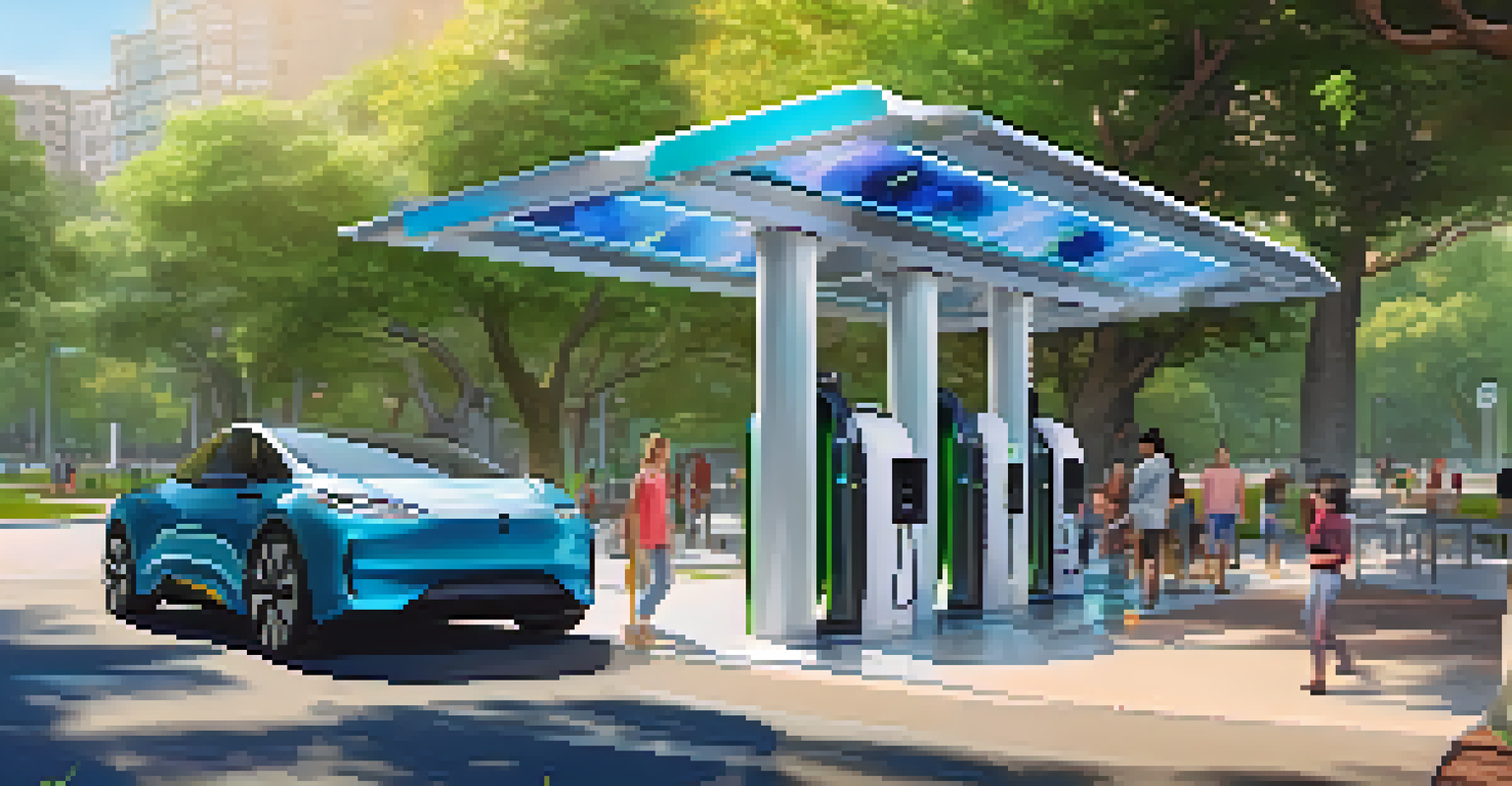Analyzing the Role of Electric Vehicles in Urban Traffic Systems

Understanding Electric Vehicles and Their Growing Popularity
Electric vehicles (EVs) have gained significant traction in recent years, largely due to growing environmental awareness and advancements in technology. As cities become more congested, EVs offer a cleaner alternative to traditional gasoline-powered cars. They not only reduce greenhouse gas emissions but also contribute to quieter urban environments, enhancing the quality of life for residents. The increasing availability of charging stations is further fueling their popularity among city dwellers.
The future will be electric. There's no doubt about it.
Moreover, government incentives, such as tax credits and rebates, encourage consumers to make the switch to electric. This shift is not just a trend; it reflects a broader commitment to sustainable urban living. Additionally, as more automakers enter the EV market, consumers are faced with a wider range of options, making electric vehicles an appealing choice for many.
In summary, the rise of electric vehicles is a reflection of changing consumer preferences and societal values. By prioritizing sustainability, urban areas can improve air quality and reduce their carbon footprint, paving the way for a greener future.
The Relationship Between EVs and Urban Traffic Congestion
Urban traffic congestion is a pressing issue for many cities around the world. With more vehicles on the road than ever before, finding effective solutions is essential. Electric vehicles can play a crucial role in alleviating this problem, as they often come equipped with advanced technologies that promote efficient driving and navigation. For instance, many EVs are integrated with apps that help drivers find the quickest routes, reducing travel times.

Additionally, as EV adoption increases, cities can implement strategies such as dedicated lanes for electric and hybrid vehicles. This not only incentivizes more drivers to consider electric options but also helps to streamline traffic flow. By transitioning to a fleet of electric vehicles, urban areas can experience a notable reduction in congestion levels, especially during peak hours.
EVs Reduce Urban Pollution
Electric vehicles produce zero tailpipe emissions, significantly improving air quality in densely populated urban areas.
Ultimately, the integration of EVs into urban traffic systems can lead to a more organized and efficient transportation network. As cities embrace this change, residents can expect smoother commutes and a decrease in the frustration associated with traffic jams.
Environmental Benefits of Electric Vehicles in Urban Areas
One of the most significant advantages of electric vehicles is their potential to reduce pollution in urban environments. Traditional vehicles emit harmful gases that contribute to air quality issues, while EVs produce zero tailpipe emissions. This shift can lead to cleaner air, which is crucial for public health, especially in densely populated cities where respiratory issues are prevalent.
Sustainability is no longer about doing less harm. It's about doing more good.
Moreover, as cities implement more renewable energy sources for charging stations, the overall carbon footprint of electric vehicles diminishes further. For example, powering EVs with solar or wind energy maximizes their environmental benefits. This synergy between renewable energy and electric transportation not only promotes sustainability but also encourages communities to invest in greener energy solutions.
In essence, the environmental benefits of electric vehicles extend beyond just reducing emissions. They represent a vital step toward creating healthier, more sustainable urban spaces that prioritize the well-being of residents and the planet.
Economic Impacts of Electric Vehicles on Urban Infrastructure
The integration of electric vehicles into urban traffic systems can significantly influence local economies. By reducing dependence on fossil fuels, cities can lower transportation costs for residents and businesses alike. This shift not only saves money for drivers but also allows municipalities to redirect funds toward other essential services, such as public transportation and infrastructure improvements.
Moreover, the rise of EVs has sparked new industries and job opportunities, from EV manufacturing to charging station installation and maintenance. As cities adapt to accommodate electric vehicles, there's a growing demand for skilled workers in these emerging sectors. This economic growth can lead to a more vibrant local economy, benefiting the community as a whole.
Economic Growth from EV Adoption
The rise of electric vehicles fosters new industries and job opportunities, boosting local economies and reducing transportation costs.
In summary, the economic implications of electric vehicles extend well beyond individual savings. By fostering new industries and promoting sustainable practices, cities can create a more robust economic landscape that supports growth and innovation.
Challenges of Integrating Electric Vehicles in Urban Traffic
While electric vehicles offer numerous benefits, integrating them into existing urban traffic systems presents several challenges. One primary concern is the need for adequate charging infrastructure. Many urban areas still lack sufficient charging stations, which can deter potential EV owners from making the switch. Without a robust network of chargers, drivers may find it inconvenient to rely solely on electric vehicles.
Additionally, there are concerns about the initial cost of purchasing an electric vehicle, which can be higher than that of traditional cars. Although long-term savings on fuel and maintenance are often touted, the upfront investment can be a barrier for some consumers. Addressing these financial hurdles is crucial to promoting widespread EV adoption.
In conclusion, while the integration of electric vehicles into urban traffic systems holds promise, it also requires careful planning and investment. Overcoming these challenges will be essential in realizing the full potential of electric vehicles in enhancing urban mobility.
Technological Innovations Supporting EVs in Urban Settings
Technological advancements are playing a pivotal role in the success of electric vehicles in urban environments. From improved battery technologies to smart charging solutions, innovation is driving the transition toward more efficient electric mobility. For example, the development of fast-charging stations allows EV owners to recharge their vehicles quickly, minimizing downtime and making electric vehicles more practical for everyday use.
Furthermore, the rise of autonomous driving technology is set to revolutionize urban transportation. Self-driving electric vehicles could significantly reduce traffic congestion and improve safety on the roads by minimizing human error. This synergy between electric and autonomous technology can lead to a more efficient and user-friendly urban transport system.
Future Trends Favor EV Integration
As cities focus on sustainability and technological advancements, the demand for electric vehicles is set to grow, reshaping urban mobility.
Ultimately, the ongoing technological innovations surrounding electric vehicles will shape the future of urban mobility. As cities embrace these advancements, they can create more sustainable, efficient, and accessible transportation options for all residents.
Future Trends for Electric Vehicles in Urban Traffic Systems
Looking ahead, the future of electric vehicles in urban traffic systems is poised for exciting developments. As more cities adopt policies aimed at reducing carbon emissions, the demand for electric vehicles is likely to grow exponentially. This trend aligns with global efforts to combat climate change and suggests that electric mobility will become a key component of future urban planning.
Moreover, innovations in battery technology are expected to enhance the range and efficiency of electric vehicles, making them even more appealing to consumers. As these advancements continue, electric vehicles will likely become the preferred choice for many urban commuters, further driving their adoption.

In summary, the future of electric vehicles in urban settings looks bright. By embracing these trends and advancements, cities can pave the way for a more sustainable and efficient transportation landscape that benefits both residents and the environment.